Media | Articles
Do you know what these 8 badges mean?
Sitting in traffic can be boring. There often isn’t much to look at. A few personalized license plates to decode, or maybe a pretty sunrise or sunset to soak in, at best. I find myself often trying figure out what the badges on the back of the cars in front me you mean.
While the badging on modern cars is largely meaningless, there was a time when automakers peppered alphanumerics all over a car’s doors, fenders, pillars, and bumpers. It was a form boasting that showcased the car’s technological advancements and performance to anyone looking.
Those signals could be quite complex. You might need a decoder book, an engineering background, and an MBA to make sense of these four- or five-letter jumbles. These acronyms and initialisms pertained to the car’s transmission, engine, all-wheel drive system, or maybe a modest option code that sounded more like a radio station you’d pick up in the far corners of Kansas.
Thanks for tuning in to 94.3 SH-AWD! Up next we have a brand-new track off Sting’s new album!
We put our heads together and came up with a selection of badges—some well-known, some more obscure—and hunted down what each one meant. Should you stumble across one of these examples while gridlocked, the list below should provide you with some neat trivia to impress (or bore) your passengers.
Marketplace
Buy and sell classics with confidence
LTD

While cars can sometimes seem like a Life Time Decision, that is not what LTD stands for. Nor does it stand for Love, Togetherness, and Devotion, but we could all benefit from being Back in Love Again with a quality automotive emblem like the Ford LTD.
No matter, when trim packages were introduced, the labels needed to create a hierarchy, clearly outlining which models were the feature-packed examples. Ford thought the best way to do so would be to make plain that one particular trim was Limited, which shortened nicely to LTD on the 1965 Ford Galaxie. Apparently it worked; by the late 1970s the Galaxie moniker was gone, and the LTD became the King of Dearborn.
RS/SS
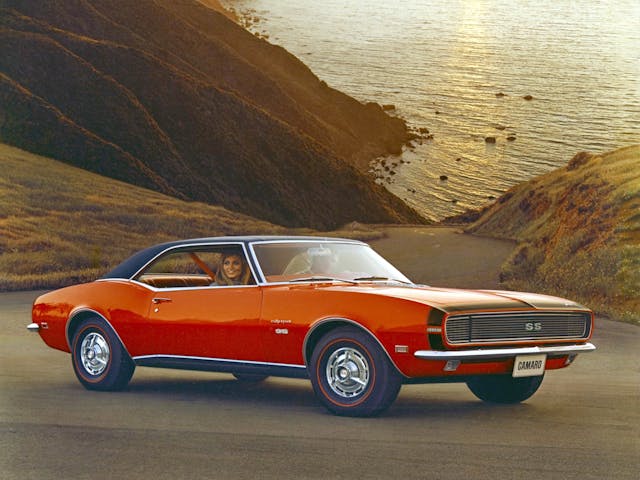
Just as Ford wanted to distinguish one trim as “Limited,” Chevrolet sought slice up the Camaro lineup in the late 1960s. Buyers could step up from the base trim to the RS, which stood for Rally Sport. Making the leap scored you hidden headlights, revised taillights, and some additional brightwork. From there, you could step up to the SS package, which was short for Super Sport and was targeted at buyers wanting additional power and handling capability.
4WS
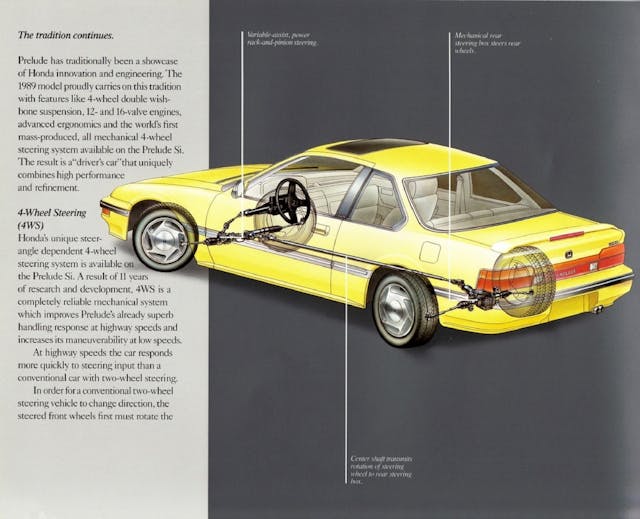
When numbers enter into the mix, you know things are getting complicated. Four Window System? The emblem was mounted on the B-pillar, after all!
But wait, that doesn’t make sense because this bit of tech debuted on the two-door Honda Prelude coupe. It’s actually a shorthand for Honda’s four-wheel steering, first introduced on the Prelude for the 1987 model year. The entirely mechanical system dialed in a relatively small amount of counter-steering to the rear wheels at slow speed to improve the turning circle, and it could also angle the rear wheels in the same direction as the fronts at higher speeds for better stability.
OHC/FI
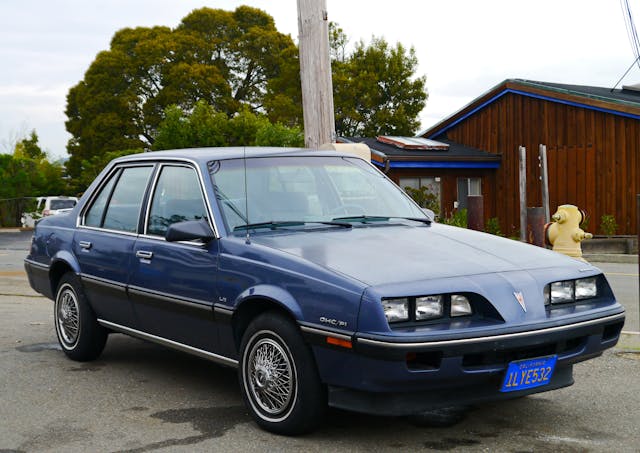
Five letters with a slash. Things are getting serious now! Or at least, Pontiac thought its tech was getting noteworthy with the combination of an overhead camshaft and fuel injection on the 1.8-liter fuel injected engines found in the J-body based Pontiac Sunbird. (This Opel-derived motor was also used in the Oldsmobile Firenza and Buick Skyhawk, but without Pontiac’s unique emblem.) Did many/most vehicles of the era feature at least one overhead camshaft and fuel injection? Well, sure. But were they advertising it on the front of the fender? Gotta respect Pontiac’s hustle.
SVT

Super Very Torque? I mean, you do only see this badge on quick cars. Born in 1991, Ford’s Special Vehicle Team (SVT) was a skunkworks division dedicated to niche high-performance vehicles. While not particularly a creative initialism, the team was responsible for some heavy-hitting machinery including the 1993 Mustang Cobra R, 2005–2006 Ford GT supercar, and the first Ford Raptor pickup. Ford formally closed down SVT in 2015, but the legacy of this badge will be remembered fondly in the hearts of Blue Oval fans everywhere.
ALB

Another Honda entry to the list, like the 4WS emblem, also appears on the B-pillar. While ALB sounds like a minor-league baseball organization, it’s not (we think). On Hondas, ALB was just a simple abbreviation for anti-lock brakes that predated the commonly used ABS (anti-lock braking system). Of course, ABS is ubiquitous and thus nothing to brag about, but ALB marks a time when it was something to be proud of.
HICAS and Super HICAS
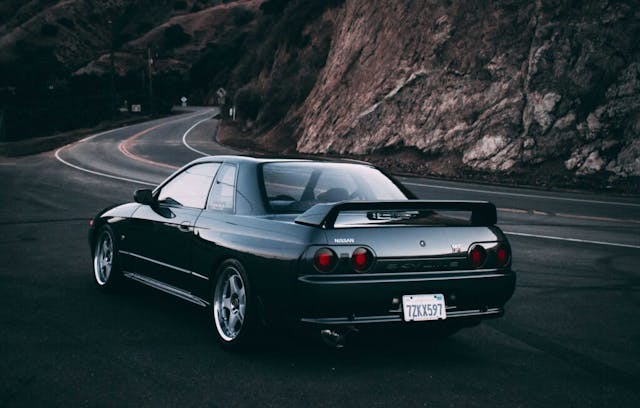
Whoa, that’s a lot of letters! HICAS stood for High Capacity Actively Controlled Steering, a rear-wheel steering system that Nissan first introduced on the 1986 Skyline GTS coupe. The system utilized the power steering pump to push fluid through a hydraulic circuit that would adjust the angle of the rear rollers based on input data from speed sensors. Starting with the R33 (1993–97) Skyline, the system swapped out the hydraulic controls for an electronically actuated system, which Nissan subsequently dubbed Super HICAS.
XR4ti

Where do we even start here? It is often safe to assume that ‘X’ is representative of ‘experimental’ in the land of European Ford and 1960s Lincoln-Mercury products—just pay no attention to the fact that Nissan came out with the Xterra and BMW stepped in with X-branded crossovers to muddied everything up. This particular string of letters does indeed start with ‘experimental,’ though it was only truly experimental for the North American market. From 1985 to 1989, Ford imported the three-door Sierra XR4i model and labeled it a Merkur XR4ti.
Long story short, XR4ti stood for Experimental (X) Racing (R),four cylinders** (4), Turbocharging (t), and fuel injection (i). That makes for a pretty cool package, but when shortened it looks more like a letter salad. Bob Lutz probably coulda been a little clearer with this one. That said, the 4 originally meant that it was the high performance version of the Ford Sierra, which was called the XR4.
You might be more likely to see these particular emblems at a RadWood event than in an everyday traffic jam, but knowledge is power nonetheless. We do occasionally have to eat and sleep, so we admit that what we’ve discussed here is a fraction of what is out there in wild, waiting to be decoded. Help us expand the list with a comment below and share your knowledge!
**There’s some intentional confusion here, as the “XR4” in XR4ti was originally designated as the largest of the three experimental racing creations from Ford of Europe. There was the smaller Escort XR3 and Fiesta XR2 before it. So you can either refer to it as four cylinders in American parlance, as it makes complete sense with the “t” and the “i” after, or the original definition of it being a larger hatchback in Ford’s performance portfolio.
***
Check out the Hagerty Media homepage so you don’t miss a single story, or better yet, bookmark it. To get our best stories delivered right to your inbox, subscribe to our newsletters.
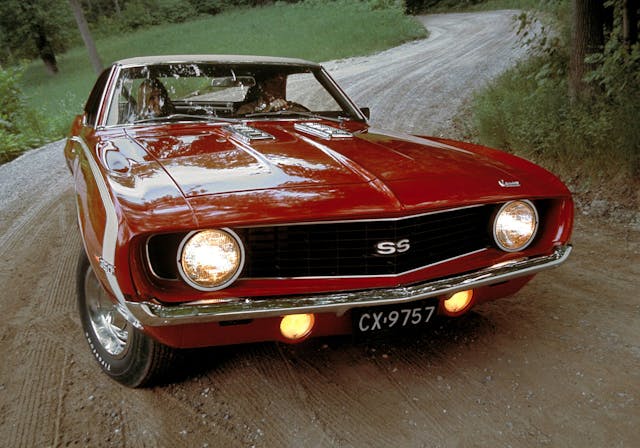







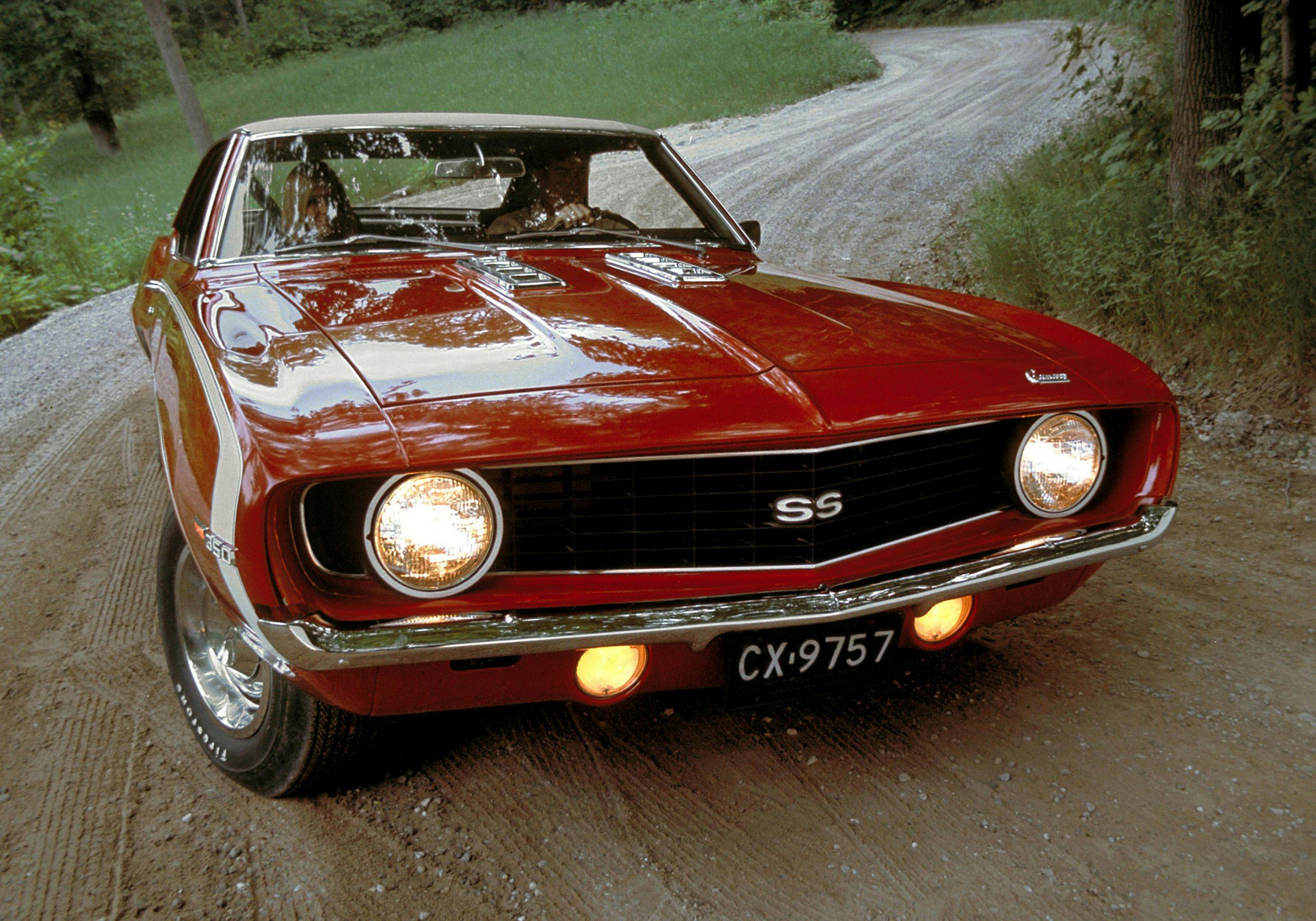
I know what POS means too. And LOL!😄
POS = “Point of Sale”; I learned that term while working in the retail industry.
I have heard POS used to describe a vehicle that someone was more than a little unhappy with. (Pile of S—)
or………….Piece of S….
🤣👏🤣
I used to see P.O.E. on import car price tags decades ago, but since then… nevermore.
(Port of Entry, and yeah that joke was a stretch.)
And LOL = Lots Of Love
I always thought it was Laugh Out Loud.
WTF?
Wow, That’s Fantastic?
That was what I was thinking…. I did not do too well on decoding the badges.
But at least I do know what LP stands for on the LP400 (even though I don’t speak Italian!).
Lotsa Problems?
World Trade Federation.
They are responsible for the mess we are in now. LoL.
OMG!
Actual badge misreadings I have personally heard. not making these up:
1. Exrauti (XR4Ti)
1. High n’ Dry (Hyundai)
3. Suzuki Cimmaron (Samurai)
4. Down in the Country (Chrysler T&C)
Oh, and the ever popular “Who makes the Undo?” from the person bending down to read th knockoff hub.
Don’t Trudge It — Rudge It!
ISTR Rudge was the wheelmaker who first used “Undo,” to the puzzlement of gas station attendants everywhere.
Funny – there is a cool Tee with that story: https://abqsupply.com/collections/mens/products/rw-coventry-tee
Good ones, Ralph!
I always thought the 4 looked like an “A”, so I secretly called it the XRATI.
What, that’s a 4? I’ve been calling it an XRATI for nothing? No wonder I couldn’t figure out what it stood for! 🙄
My sister in law was convinced for many years that XR4Ti stood for Zerati. I kid you not
That reminds me of a podcast I once listened to where the person had thought into adulthood that Ped Xing signs were said out loud as ‘ped zing’.
My favorite was a newspaper classified ad for a “1964 VW Common Gear”
I’m going to say that was when newspaper ads were phoned-in. 🙂
I’ve heard Jaguar’s big Sixties sedan pronounced “MKX” instead of “Mark Ten” – the guy probably thought it was like “XKE”.
I got almost all of them!
Here are a couple that I’ll bet most folks will get wrong:
GTO, (Italiano.)
GMC’s original meaning.
Grand Turismo Omologato – although I probably butchered the spelling… don’t know the other one
Gutless Take Off 🙂
My Mopar buddies used to tell me ” Get the Tools Out”.
I own a ’66 GTO.
GMC originally stood for Grabowsky Motor Company, the original name of the outfit before General Motors got their hands on it.
The Grabowsky thing keeps coming up as fact. It was not named for them. The grabowsky brother owned 2 companies Reliance and Rapid which GM bought. They where rebranded as GM Truck 1909 logo added 1911 and shortened to GMC in 1913. Rapid and GMC where on the property where M1 is located n Pontiac MI
Begging your pardon, sir, but the Grabowsky Motor Company was formed in 1902. Reliance/Rapid came after a reorganization just before Mr. Sloan came knocking, looking to buy a truck company. And just like David Buick’s deal, the name had to remain.
No, GMC stood for General Motors Corporation. Nothing more, nothing less.
And then there’s the Isuzu VehiCROSS…Vehicle Cross-country or Vehicle Is Angry.
Gas Tires Oil
Garage Mechanics Companion
Sorry. Nothing beats ol’ Carroll’s GLH and GLH-S.
Those are among the best,for sure. And then there was the Mazda GLC. Great Little Car.
Yes
The original Super Sport option on the 1963 Nova had nothing to do with handling or more power. It added a console (powerglide only), bucket seats, gauge package and clock in the cluster, and Nova SS badges. All came with the 194 cid 6 and either powerglide 2 speed auto, or three speed manual(on the tree).
Always struck me as odd, seeing a Nova SS with a 6! I’ve seen a couple around town and thought they were knockoffs. Surely an SS would have a V-8!
My neighbor had a Malibu SS. 6 cyl 3 on the tree, I believe it was a 63. Factory stock bought new.
We had a 1963 Nova, got it in 1964 after it had been a drivers training car the previous summer. We always said the SS badge stood for Super Slush as a description of the 2 speed transmission. 😉
Don ; I think they dubbed that 2 speed as a Power Slide Trans
Around Detroit it was known as the “peanut butter glide”
The OG SS was in the 1961 Impala. Very rare option which got you the beefed up suspension and the 409. So, no slouch there. They did water it down over the years as in the Nova as you mentioned but when first offered it was the real deal.
Years ago my wife and I were driving on a country road on the big island of Hawaii. We saw a hand painted sign on a tight bend where a residential driveway joined. It said “SLO DWN MATA FAKA”.
We had to reverse and read it a couple times before it clicked…..too funny!
I still have my stock six-cylinder 1963 Nova SS convertible with factory air conditioning. One year only Cordovan brown with the saddle interior. Best $700 I ever spent.
Also, the OHC/FI J-bodies were not the Tech IV. The OHC/FI was a Brazilian built 1.8L single overhead cam fuel injected engine that ran circles around the standard Chevrolet OHV 1.8L 4 cylinder carbureted base engine in the J cars. I had the 1982 J2000 wagon with 1.8L carbureted engine that was, in my mind at the time, the slowest car ever known to man. It did have a really nice 4 speed shifter though, and I could hold my foot to the floor and shift through all 4 gears with lightening speed (the shifting, not the acceleration).
Oof. You are right and I likely gave the author bad information. Thanks for this, we have corrected this error.
My Pontiac Sunbird had the Brazilian engine with a Turbo. The worst car I ever owned. It was really quick, but every time you got on the gas, it would blow the head gasket… probably because it bent the needle on the boost gage. After 3 years of letting it sit in my back yard with weeds growing through the wheels, the court decided that it needed to go back to the dealer and I would get my money back.
Basically, nothing worked. seat spring broke and poked through the seat, tearing my wife’s dress, windsheld broke driving down main street. Wipers made one sweep every time we went by a Burger King (kids thought it was haunted). Electric windows didn’t work at all. Dealer ran the odometer ahead by 12,000 miles while it was in their shop, to get out of the warrantee, but I had proof. They changed the Turbo twice, the head once, 2 brake jobs for warped rotors, and finally a new engine ( which turned out to be a short block from a junk yard). That job necessitated that the car sit in the dealer’s backlot covered by the snow bank for 5 months. In 3 years of ownership, We actually used the car for 6 months. The rest of the time was spent in the dealership shop.
Starting the car in the driveway, the only thing you could see was one tail light peeking through the smoke.
The best day was when they came to get it and put it on a flat bed. My lawyer handed me the check and the dealer paid my lawyer. By the way, it was a Pontiac Dealer who now sells Chevrolets.
No worries and nice job on the correction! As usual, above and beyond.
Thank you, you are too kind.
Another for LTD was Long Term Debt since it cost more than a Galaxie.
GMC stands for GARAGE MAN’S COMPANION
All that, and the article still didn’t explain what ‘LTD’ stands for. Guess the author was to busy, impressing himself. Probably should hire a proof reader..
Not really sure about that:
“Ford thought the best way to do so would be to make plain that one particular trim was Limited, which shortened nicely to LTD on the 1965 Ford Galaxie.”
Limited
In fact, the article DOES say what LTD stands for. And, no need to be rude; it adds nothing to the dialog that many of us enjoy on this website.
Funny, because I had an uncle who was a Chicago cop and always bought LTDs with the biggest engines available. I know it’s an irony, but our family was always under the impression that it stood for “Luxury Two Door” – even though it was possible to get a four-door “LTD”!? The brakes were so over-boosted you could stop the 2 ton car with your baby toe, which scared the crap out me the few times I drove it. I used to joke that it must stand for “Light Touch Deceleration”.
The idea of LTD supposedly standing for “Luxury Two Door” is fantastic. If only Mercedes had known, they could have really annoyed people by applying it to their CLS…
It was always LTD’s where I come from.
In high school a friend had an LTD.
Lick The D**k we called it. Definitely a POS.
I guess someone was too busy to read the article, probably more interested in flaming the author.
No letters, just numbers.
442
I have read in the past that it originally stood for 4 barrel carb, 4 speed manual trans, and dual exhaust.
Or maybe it was 400 ci engine, 4 barrel carb, and dual exhaust. My memory isn’t what it used to be.
Correct on both counts. When 400ci became available so did the option of an automatic transmission.
Either way it’s just another sad example of Olds building great cars and having lousy stinking (LS ?) Branding and marketing.
Yes, that is correct. ^^^^^
The first one; the carb, trans, and exhaust
How about Toyota’s, SR5? It stands for Single Rail 5 Speed. In the 80’s and 90’s it represented the interior shifting mechanism design of their light truck manual transmission.
Now it’s plastered everywhere and holds no meaning – especially when stuck on an automatic transmission equipped pickup.
I’ve praised this site multiple times for constantly teaching me new things. Today, I do it again! I’ve owned three SR5 pick-ups in my life, and yet never knew what it stood for. Thanks for the article, Hagerty, and thanks to Rob for the enlightenment!
Who remembers when RS actually meant something, unlike today’s ‘RS lineup’ from the automaker. I hope they never butcher the SS logo like they did the RS.